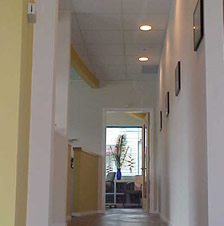The Artist as Entrepreneur |
Ken
Domash
|
Ken
Domash
grew up in the St. Louis area. He attended Chaminade and Vianney
high schools, but was able to attend art classes at Washington
University while still a high school student. At the same time he was
honing his talents as a magician.
At Maryville University, Domash pursued a practical application of his art in interior design. He furthered his vision with an advanced degree in real estate management and a real estate broker's license. His becoming a registered architect then allowed him bring his projects to fruition. After working for Alternative Office Solutions for a year and a half, Domash began his own business operating initially out of his home. His company was then located in Kirkwood on Monroe. Now Domash Designsource LLC is at 8780 Big Bend Boulevard in Webster Groves. Domash fully designed their space to emulate their logo brand. Domash married a St. Louisan, Aimee, who has also been involved with the business managing records, health benefits, payroll, and bookkeeping. They have three children and live in a home designed by Domash – ground up. The following interview with Ken Domash was conducted by Cheryl Blake, UM-St. Louis, September 2004. Q. How did you come to this point in the business and your career? A. I was a professional magician at age 18. I thought about being a magician. I was offered scholarships at Webster for art when I was a junior. I could have skipped my senior year and had a full ride, but one of my friends asked if I was crazy thinking of not staying in high school for senior year. I did get to take art at Washington University while I was still in high school. When I graduated, I went on to Maryville University. My dad advised me to do something practical with the art. So I chose interior design. I went to Webster University for real estate management and became a broker so I could do what my clients at the time were doing, that part of design. I really like the people in the business, their personality structure. They are a really outgoing group. However, the actual work that the brokers do would not allow room for drawing – in any form. So I did the art part for this group. They are now my clients, and I do the creative part of their deals. Yet, although I could do the creative part, I needed to be an architect to sign off on my own work… I had worked with architects for years. They had even worked for me. I applied to the Missouri Board of Architecture to sit for the exam to become registered. I had 12 years of day runners, and the architects I'd worked with signed off on what we had done. Some of my studies at Maryville also counted. It took a year and a half, but the board approved me. Then I had to memorize like a maniac. I was able to keep up the business, but I would go home from work and study until midnight. After three years of cramming I took the nine exams, five of them all-day tests. I passed and received my architect’s seal. Q. Why was the architecture important?
Q. Do you have any advice for people who want to combine their art with a successful business? A. The magic trick is using your art and creativity to pull off your business illusion. What I like to do is draw. That is my art. I can sit with someone and draw the design as we talk about it. I get to draw, do what I love. My dad's advice to get something that has practical applications was good. I would suggest getting something that has certifications. If there are difficult requirements and a heavy price for an entry fee, like the education for architecture, then the supply stays low.
When I started out, I told myself that I was going to do branding.
I get to create new all of the time. I'm selling new ideas everyday
with the use of art. copyright 2004, Center for Entrepreneurship and Economic Education, University of Missouri-St. Louis
|


